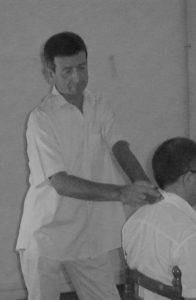 Spinal Reflexology or Spondylotherapy, consists en applying percussion or pressure techniques to the spinal vertebrae on certain points located along these same spines. In his book entitled “Les méthodes d ‘Abrams” translated in French by Dr. Regnault ( Maloine editions 1927). Dr. Abrams presents an original method of treatment that involves making a stimulation by light percussion over the spinous process of a vertebra.
Spinal Reflexology or Spondylotherapy, consists en applying percussion or pressure techniques to the spinal vertebrae on certain points located along these same spines. In his book entitled “Les méthodes d ‘Abrams” translated in French by Dr. Regnault ( Maloine editions 1927). Dr. Abrams presents an original method of treatment that involves making a stimulation by light percussion over the spinous process of a vertebra.
This percussion will cause stimulation of the body segment corresponding to an organ in relation to the segment in question, and acts upon the ganglia and the nervous system (both sympathetic and parasympathetic). For example a patient with gastritis may present a vertebral displacement and pinching at the level of the sixth or twelfth vertebrae of the thoracis spine. The correction of the vertebral displacement through gentle manouvers will assist the solution of the condition.
A neurotoma is also known as a neuromera or neural segment, which are originally elevations on the wall of the embryonic neural tube development, towards which the dorsal and ventral roots or peripheral nerves are connected. Neurological studies of innervation in the body system have revealed a division of areas of the body, in which each rib corresponds to a segment of the spinal cord that innervates. The Neurotomas are a part of the spinal cord at which a pair of dorsal roots and a pair of ventral roots are connected, they are also called neural tube.
Each neurotoma (nerve plexus of the spine) is connected to specific internal organs, in particular to specific tendons ligaments and muscles,specific bones, and a specific surface area of the epidermis.
Any kind of functional modification of these systems is reflected in the connecting system by the neurotoma. The result is a muscular, tendon problem, or bone problem, or one concerning an internal body organ, are manifested in a specific area of the body. Furthermore, stimulation of the skin or muscle or nerve concerned causes a reflective effect on the corresponding internal organ, positively influencing the course of disease.





